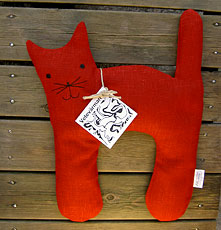
Strangely enough, I´ve never really felt comfortable with Santa Claus... One part of the explaination might be, that the Swedish father Christmas is more of a kindly gnome who lives with the animals and takes care of them rather than a jolly old man.

The image of the tomte is for me strongly inspired by a poem by Viktor Rydberg (Swedish copy here, bad English translation here). But parallel to the image of the tomte, we´re overwhelmed by pictures of the American Coca-Cola Santa, that I never really felt connected to. I feel this is quite confusing, and mostly decorate with snowmen instead =)
But just a few days ago, I went to a lecture in the Freiburger Münster church, and it was among other things about the original Santa, about St Nicholas. He was bishop of Myra , present day Turkey (but then a Greek colony ) in the 3rd century. According to the legend, his parents died when he was still a child, which led him to a soul-searching adolesence that eventually made him a Christian. There are different stories told about him:
He is known as the patron saint of sailors, and is supposed to have saved a sailor from falling from the ship´s rigging in a storm. Another legend is about a ship that had been suffering from no wind for a long time. The crew were thirsty and hungry, and about to run out of food if they couldn´t make it to shore soon. They prayed to St Nicholas, and the sails filled with wind.
Saint Nicholas is also the patron saint of children. One legend tells how a terrible famine struck and a malicious butcher lured three little children into his house, only to kill and slaughter them and put their remains in a barrel to cure, planning to sell them off as ham. Saint Nicholas, visiting the region to care for the hungry, not only saw through the butcher's horrific crime but also managed to resurrect the three boys from the barrel.
Lastly, St Nicholas is also seen as the patron saint of women. In the most famous story, a poor man had three daughters but could not afford a proper dowry for them. This meant that they would remain unmarried and probably, in absence of any other possible employment would have to become prostitutes.
Hearing of the poor man's plight, Nicholas decided to help him but being too modest (or too shy) to help the man in public, he went to his house under the cover of night and threw three purses filled with gold coins through the window opening onto the man's floor. He threw the purses over a period of three years, each time the night before one of the daughters comes "of age". In another version, Nicholas learns of the poor man's plan and drops the third bag down the chimney instead. People then began to suspect that he was behind a large numb er of other anonymous gifts to the poor, using the inheritance from his wealthy parents. After he died, people in the region continued to give to the poor anonymously, and such gifts were still often attributed to St. Nicholas.
er of other anonymous gifts to the poor, using the inheritance from his wealthy parents. After he died, people in the region continued to give to the poor anonymously, and such gifts were still often attributed to St. Nicholas.
One of the most amazing feats of Saint Nicholas however was that he lived to a ripe old age and died peacefully in his own bed. At a time where most saints earned their place in heaven by dying for their faith in manners most unusual and cruel, this definitely made him stand out.
Somehow, this story made me feel more connected to Santa Claus, and I think I will buy an image of him to decorate at home for Christmas with (before, I only had "tomten" and snowmen and angels ). How do you feel? Who is Santa Claus to you, and what does he represent?




























 er of other anonymous gifts to the poor, using the inheritance from his wealthy parents. After he died, people in the region continued to give to the poor anonymously, and such gifts were still often attributed to St. Nicholas.
er of other anonymous gifts to the poor, using the inheritance from his wealthy parents. After he died, people in the region continued to give to the poor anonymously, and such gifts were still often attributed to St. Nicholas.























